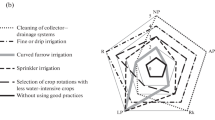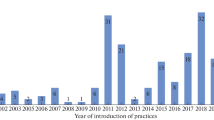Abstract
In Egypt, major sustainability variables could be identified as scarce of soil and water resources, environmental degradation, rapid population growth, institutional arrangement that includes land tenure and farm fragmentation, agricultural administration, lack of infrastructure, and credit utilization. The main objective of the current work is to evaluate the sustainable land use management (SLM) model through biophysics and socioeconomic elements for the purpose of combating sustainability constraints that preclude the agricultural development geospatially. In this research, from the geomorphologic point of view, the obtained results showed three main landscapes. They were identified in the study area as: fluviolacustrine plain, Aeolian deposits, and flood plain. The study area was dominated by some physical and chemical degradation processes with different scales breaking down the equilibrium of soil stability. The SLM model was implemented and assessed from multivariate perspective points of productivity, security, protection, economic viability, and social acceptability. Four SLM classes were outlined as follows: class I, land management practices that did meet sustainability requirements with a score ≥0.65, which represented 31.0 % of the considered agricultural study area; class II, land management practices that were marginally above the sustainability threshold and represented 12.6 %; class III, land management practices that were slightly below the threshold of sustainability and represented 8.60 %; class IV, land management practices that did not meet sustainability requirements with index values >0.1 that represented 47.86 %. As a general conclusion, it is found that land management practices tend to be unsustainable in the area under investigation for certain constraints that play motivated roles in lowering the targeted land sustainability.









Similar content being viewed by others
References
Antonson H (2009) Bridging the gap between research and planning practice concerning landscape in Swedish infrastructural planning. Land Use Policy 26(2):169–177
Band LE (1986) Topographic partition of watershed with digital elevation models. Water Resour Res 22:15–24
Bell M, Hobbs B, Elliott E, Ellis H, Robinson Z (2001) An evaluation of multicriteria methods in integrated assessment of climate policy. J Multi-Criteria Dec Anal 10(5):229–256
Berger T (2001) Agent-based spatial models applied to agriculture: a simulation tool for technology diffusion, resource use changes and policy analysis. Science Direct J of Agricultural Economics 25(2–4):245–260
Brough PA (1986) Principle of geographical information systems for land resources assessment. Oxford University Press, Oxford. p, 194
Dobos E, Micheli E, Baumgardner MF, Biehl L, Helt T (2000) Use of combined digital elevation model and satellite radiometric data for regional soil mapping. Geoderma 97:367–391
Dobos E, Norman B, Bruee W, Luca M, Chris J, Erika M (2002) The use of DEM and satellite images for regional scale soil database. In: 17th World congress of soil science (WCSS), 14–21 August 2002, Bangkok, Thailand
Dumanski J (1993) Sustainable land management for the 21st century. Volume 1: workshop summary, compiled on behalf of the organizing committee. Proceedings of the International Workshop on Sustainable Land Management for the 21st Century. Uni. of Lethbridge, Canada, June 20–26 50 pp
Dumanski J (1997) Criteria and indicators of land quality and sustainable land management. ITC Journal 3(4):216–222
EEAA (2009) Environmental description report Sharkiea governorate statistics bureaus. Environmental Press, Egyptian Environmental Affairs Agency
Egyptian Meteorological Authority (2011) Climatologically normal for Egypt. The normal for Sharkiea governorate station (1960–2011). Ministry of Civil Aviation: Meteorological Authority, Cairo, Egypt. Accessed Aug 2007
El-Baroudy AA (2011) Monitoring land degradation using remote sensing and GIS techniques in an area of the middle Nile Delta. Egypt Catena 87:201–208
El-Nahry AH (2001) An approach for sustainable land use studies of some areas in northwest Nile Delta Egypt. PhD thesis, soil science, Dept. Faculty of Agric, Cairo University
ESRI (2009) Arc Map version 9.3.1. User manual. ESRI: ESRI product, California 92373–8100, USA
FAO (2006) Guidelines for soil description, 4th edn. Rome, FAO, ISBN 92-5-105521-1
FAO (2009) Country support tool. For scaling-up sustainable land management in Sub-Saharan Africa. Food and Agriculture Organization of the United Nations, Rome
Gafsi M, Bruno L, Nguyen G, Patrice R (2006) Towards sustainable farming systems: effectiveness and deficiency of the French procedure of sustainable agriculture. Agricultural Systems No. 90, 226–242
Gold M (1999) Sustainable agriculture: definitions and terms. SRB 99–02, USDA National Agricultural Library (NAL)
Gold M (2007) Sustainable agriculture: definitions and terms. SRB 99–02 USDA National Agricultural Library (NAL) http://www.nal.usda.gov/afsic/pubs/terms/srb9902.shtml. Accessed August 2007
Hayashi K (2000) Multicriteria analysis for agriculture resource management: a critical survey and future perspectives. Eur J Oper Res 122:486–500
ITT (2009) ITT corporation ENVI 4.7 software. 1133 Westchester Avenue, White Plains, NY, 10604, USA
Klut A (ed) (1986) Methods of soil analysis (part-1) physical and mineralogical methods. American Society of Agronomy and Soil Science Society of America, Madison
Lal R, Pierce M (1991) Soil management for sustainability. Soil and Water Conservation, Ankeny
Lillesand TM, Kiefer RW (2007) Remote sensing and image interpretation, 5th edn. Wiley, New York
Malczewski J (1999) GIS and multi-criteria decision analysis. Wiley, New York
Munda G (2005) Multiple criteria decision analysis: state of the art surveys. International Series in Operations Research & Management Science 78(VII):953–986. doi:10.1007/0-387-23081-5_23
Said R (1993) The River Nile geology and hydrology and utilization. Pergamon press, Oxford
Smyth AJ, Dumanski J (1993) FESLM: an international framework for evaluating sustainable land management, World Soil Resources Report 73: Food and Agriculture Organization (FAO). Land and Water Development Division, Rome
TerrAfrica (2006) Regional sustainable land management brochure, Washington DC, USA
USAID (1988) The transition to sustainable agriculture: an agenda for A.I.D. committee for Agric. Sustainability For Developing countries, Washington D.C
USDA (2004) Soil survey laboratory methods manual, soil survey investigation. Report no. 42, U.S. Department of Agriculture: Natural Resources Conservation Service (NRCS), third edition, version 4.0
USDA (2010) Keys to soil taxonomy, United State Department of Agriculture: Natural Resources Conservation Service (NRCS), third edition
USGS Geological Survey (1998) USGS fact sheet. No. 102-96
Weibel R, Heller M (1991) Digital terrain modelling. In: Maguire DJ, Goodchild MF, Rhind DW (eds) Geographical information systems: principles and applications. Longman, London, pp 269–297
Woodfine A (2009) Using sustainable land management practices to adapt and mitigate climate change in sub-saharan Africa. Resource guide version 1.0. TerrAfrica-Regional Sustainable Land Management
Zink JA, Valenzuala (1990) Soil geographic database: structure and application examples. ITC 3:270–294
Author information
Authors and Affiliations
Corresponding author
Rights and permissions
About this article
Cite this article
Kawy, W.A.A., Darwish, K.M. Sustainable multivariate analysis for land use management in El-Sharkiya, Egypt. Arab J Geosci 7, 475–487 (2014). https://doi.org/10.1007/s12517-012-0758-4
Received:
Accepted:
Published:
Issue Date:
DOI: https://doi.org/10.1007/s12517-012-0758-4




